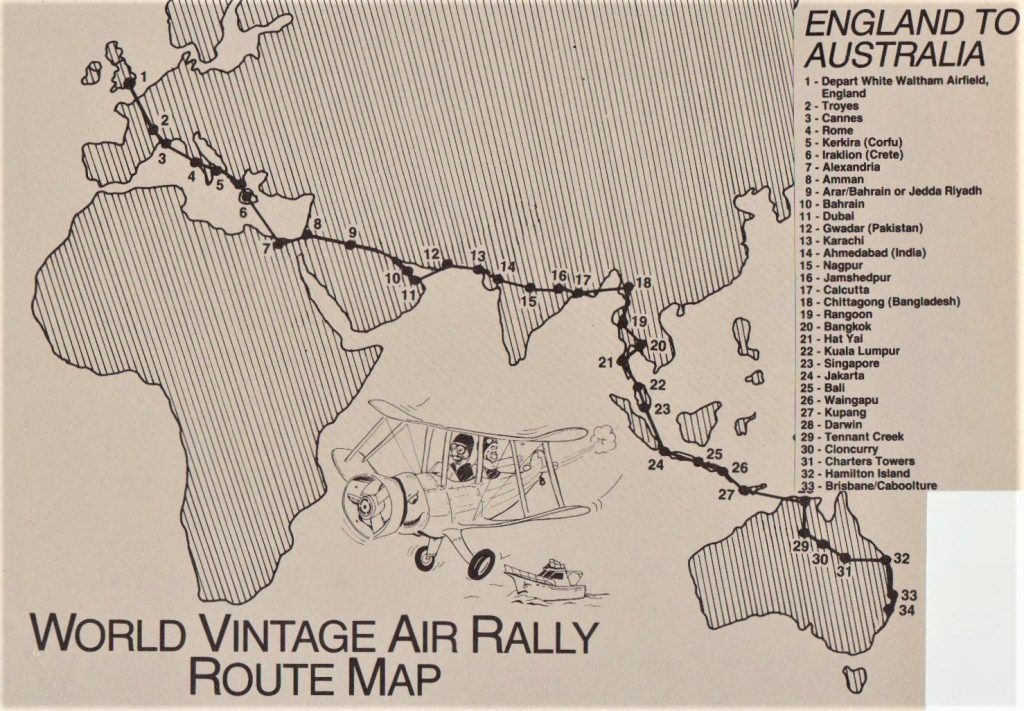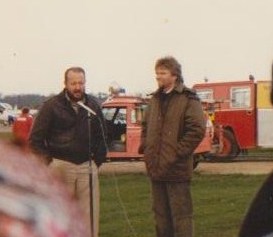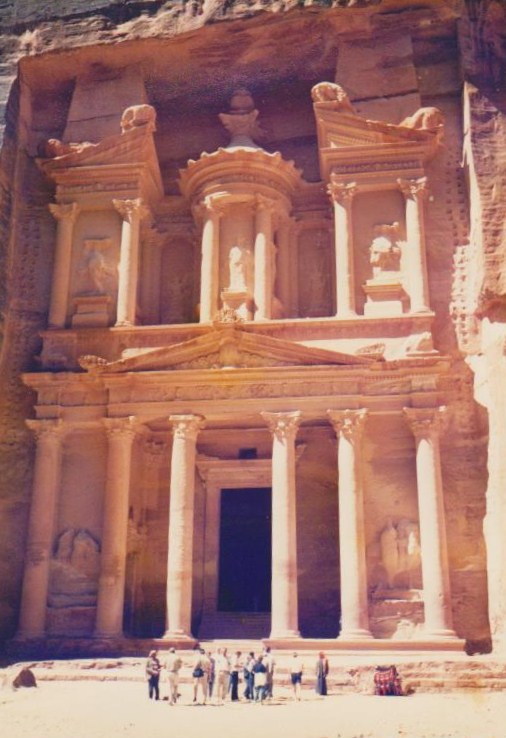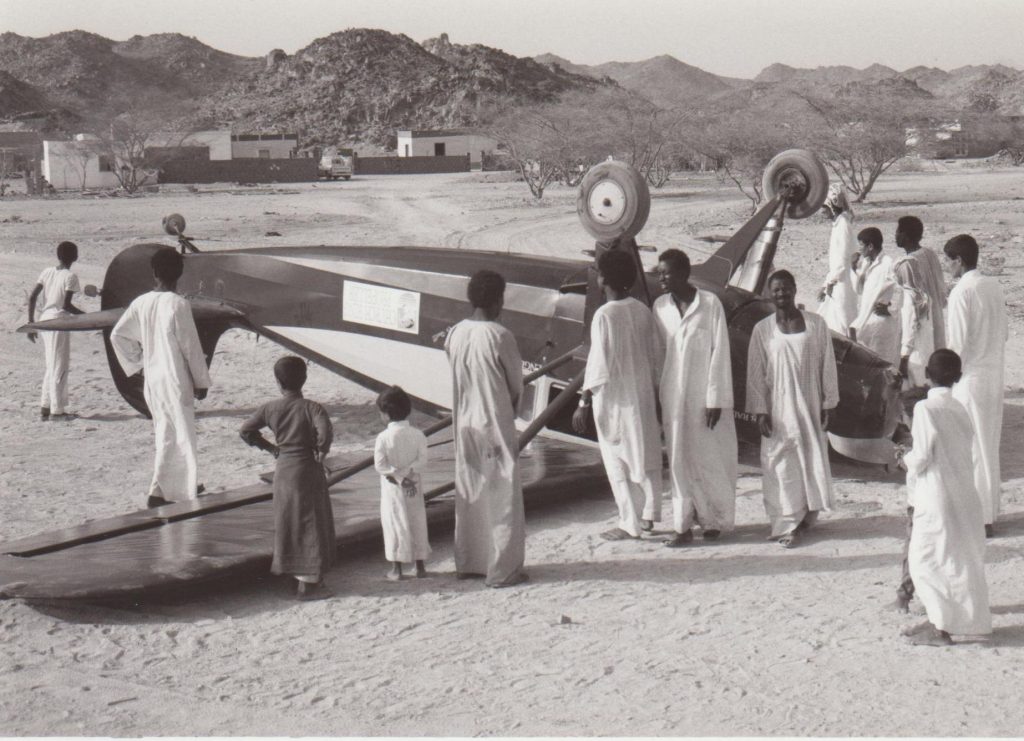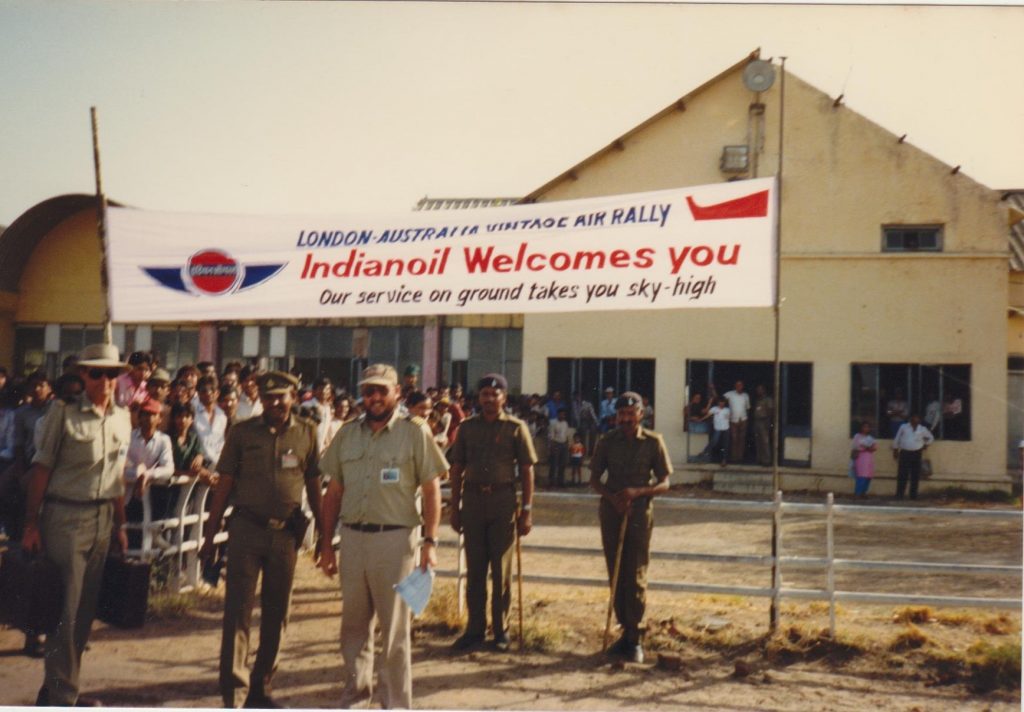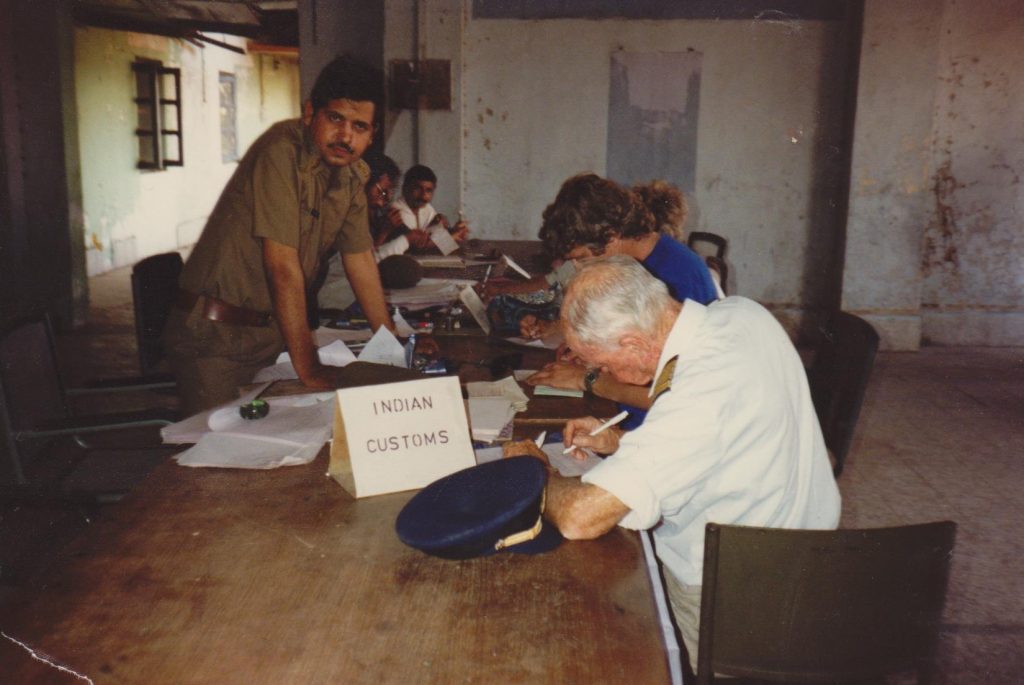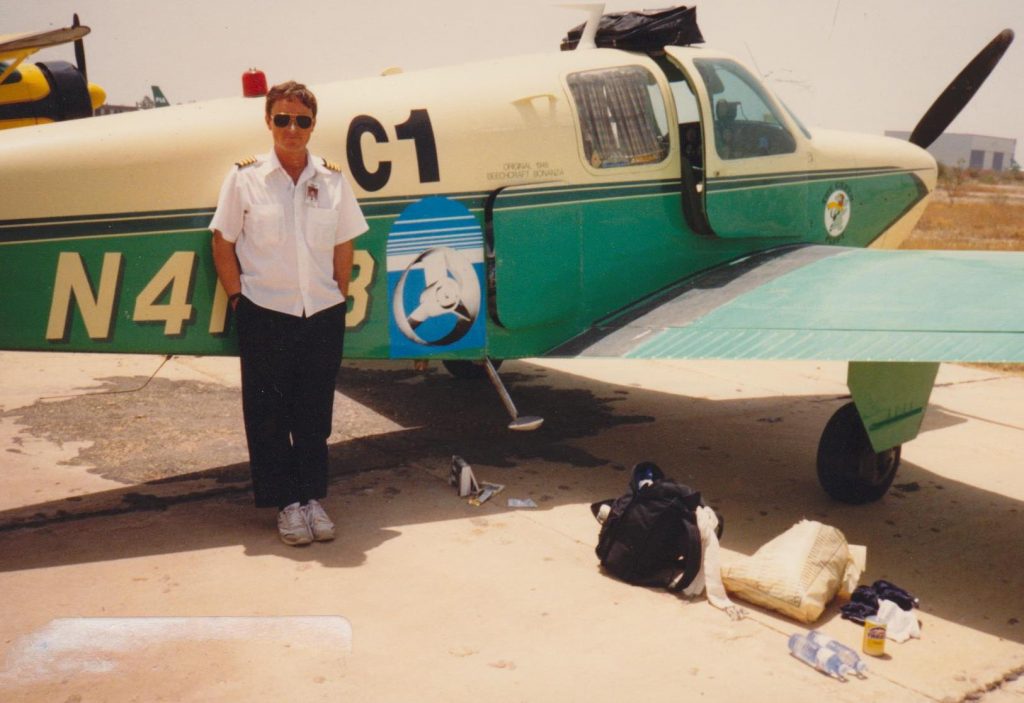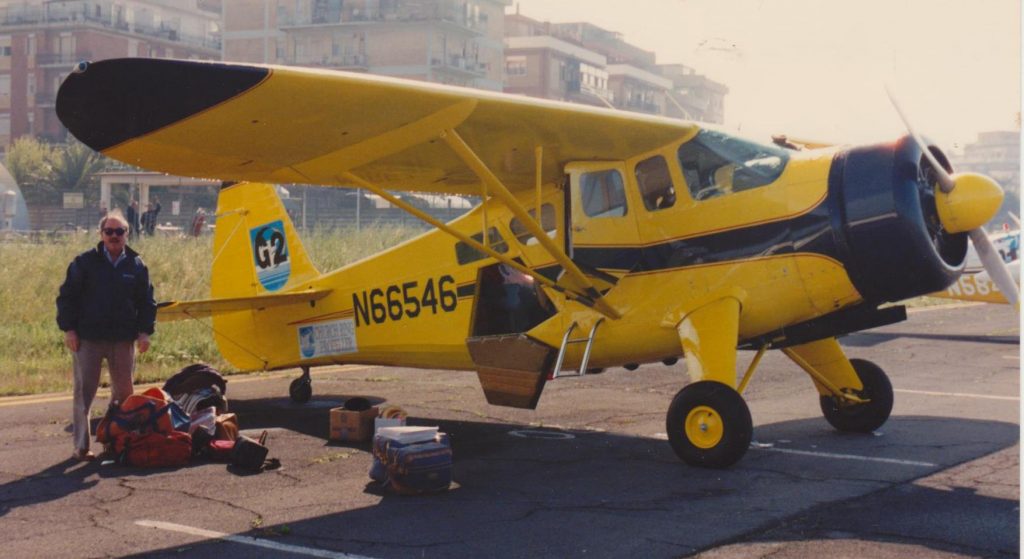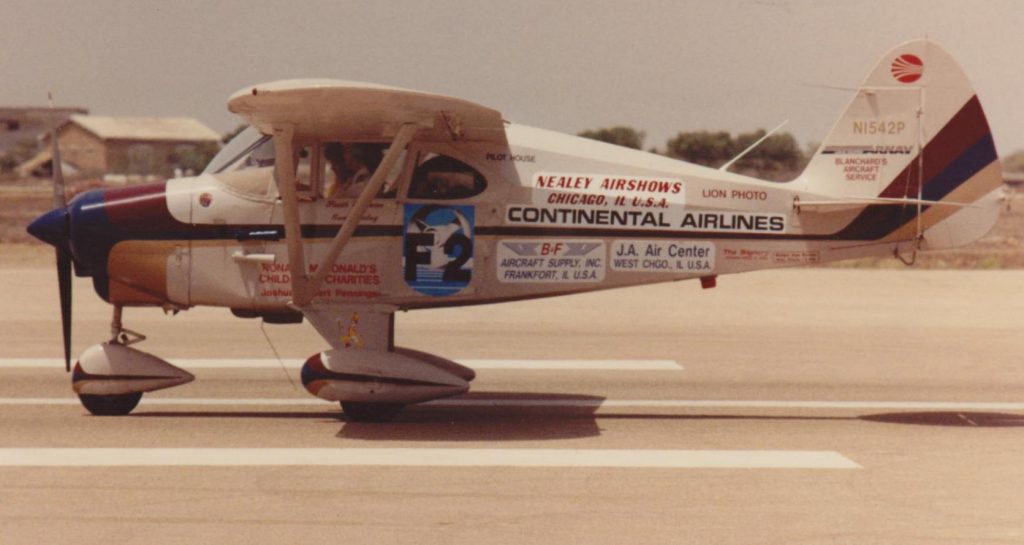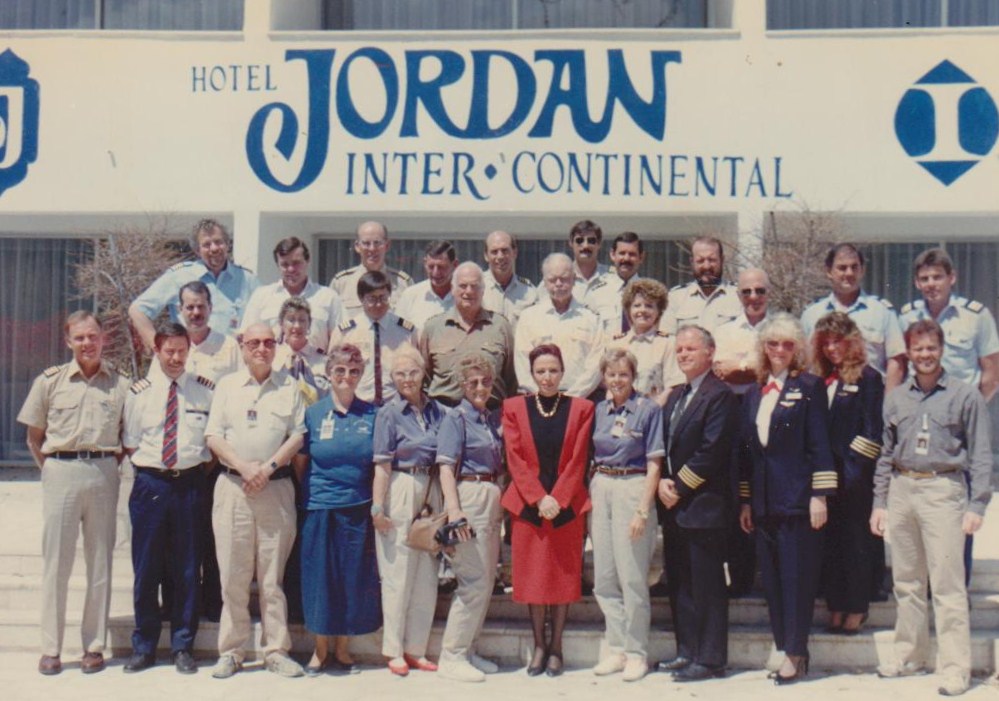1990 World Vintage Rally ENGLAND to AUSTRALIA
Rally Report
On 25 March 1990 24 aircraft, all built prior to 1950, departed White Waltham airfield near London, England to fly 10,000 miles to Australia. The bulk of the entrants came from USA and Australia, several flying their aircraft across the Atlantic to the start. Events prior to the start were dramatic with one entrant destroying his lovely Piper Pacer during practice. Other entrants suffered shipping damage to their aircraft and some were still working hard 15 minutes before the start. The smallest aircraft, a Piper Cub, did not arrive from the docks until Friday night and all hands assembled to pull it from the container. The pilot still left with jobs undone, hoping to do them along the way.
On Sunday morning of the departure the last two cross-Atlantic aircraft arrived, one appearing from Iceland only 2 hours before the start. The crews of these 1948 Bonanzas had little time to get going and one elected to leave the following day to catch up with the fleet.
On the Friday evening prior to the start a party was held at White Waltham clubhouse, complete with 1940s band. This was the first time the entire team had been together and a fine time was had by all. A two hour briefing was held by Lang Kidby, the event director, on Saturday morning where an outline of rally procedures for the first few days was discussed. Representatives of the British CAA were present to answer questions and go over points discussed at a visit to Heathrow Control Centre on Thursday evenings by most crews. The charts and planning material supplied, free of charge, by Jeppesen-Sanderson were distributed. The crews found these were sufficient for the entire trip and no one had to search for information outside that provided by the Jeppesens.
The day of departure was extremely cold with windy, damp conditions but visibility was good enough to leave. As the morning drew on the weather improved and crowds started to arrive while visiting aircraft appeared over the horizon. A selection of vintage and aerobatic aircraft put on displays, which delighted the crowd which had swollen to about 3,000 by mid-day. Despite the presence of TV and press, the crews were taking no notice, involved as they were in a frenzy of last minute activities with customs, flight planning and final repairs.
At mdi-day Richard Branson, owner of Virgin Airlines and noted adventurer, arrived at the platform to perform the appropriate speech. About 1,000 people shuffled their feet while Lang Kidby, the rally director, was found (pumping fuel for a last minute change). Richard made suitable comments, then boarded the vintage Bentley to take him to the runway where he fired a green Very flare into the air to release the Tiger Moth (escorted as far as the English Channel by 2 other Tigers). The other aircraft departed at one minute intervals into the misty sky, passing overhead the excited crowds lining the runway as they waved in the style of the twenties, roaring each time an aircraft lifted off.
The passage past the control zones of Gatwick and Heathrow caused no problems thanks to the thorough briefing by the CAA and despite strong headwinds, the fleet managed to find Troyes, in the Champagne district of France. Sadly we received the news that the Tiger Moth had crashed on landing at Le Touquet on the coast and the Piper Cub, following him in for fuel had side windows blown out by the same freak wind gust that caused the Tiger’s demise. Bill Andrews, who had flown his 1947 Bonanza all the was from Zimbabwe for the start, offered to take spare parts belonging to the Tiger (distributed amongst the fleet aircraft) all the way back to Le Touquet. He returned with confirmation our only bi-plane was finished.
The second day of the rally turned out miserable with cloud down to ground level and fifty knot winds on the surface at Dijon only 60 miles away on our track. The first layday was called and the local police commander (and president of the aero club) was persuaded to organise a tour of the area. A grand day was had by all culminating in the cellars of a champagne maker who was also a keen pilot.
The following day was also fairly substandard but all except the 4 most conservative crews decided to give it a go and managed to escape to the blue skys and sunshine of the Cote d’Azure and the town of Cannes. The Cannes weather was beautiful and the crews spent the day touring while waiting for those left behind in Troyes, where the weather had closed in for the next five days. An early departure, leaving those behind to catch up, was made from Cannes and a magnificent flight was made across the Mediterranean to Rome. Some crews chose to go direct over Corsica and Elba while others followed the coast past Genoa and Pisa.
An entry into Rome was a trying experience for all the pilots and none had ever experienced the deluge of instructions, track changes and routing around restricted areas before in their lives. Eventually all the crews were being warmly welcomed at Ciampino Aiport and were soon on their way to the Garden Hotel situated on a volcanic lake poised above the city of Rome. The compulsory bus trip around Rome ensued and everyone was photographed in St Peter’s Square and the Coliseum before returning to the hotel. The exchange rates here were probably the most blatant attempt at robbery on the whole trip.
A decision was made to catch up a day and the fleet departed Ciampino (1 hour 42 minutes from “Clear to taxi” to “Clear to take-off” was the record) and overflew the original destination of Brindisi and went to Kerkira on the Greek island of Corfu. The reception was magnificent, the hotels cheap and scenery exactly as expected of the Greek Islands. Regretfully leaving Kerkira we set out on the first of the long overwater crossings to Iraklion on Crete via the island of Milos. Bad weather over the first half of the trip caused concern for many crews but eventually all arrived between thunderstorms and strong winds at Iraklion airport. The reception was marvellous and the Australians found particular interest in standing on the site of a desperate defence against German paratroopers 50 years earlier.
A couple of days were spent waiting at Iraklion for our Egyptian clearances to come through and the time was spent touring the rugged interior of Crete, attending a huge political rally with many members of the crowd firing automatic weapons gaily into the air in their excitement and eating magnificent Greek food. During this time the fears of several weaker crews came to light and three aircraft left the rally convinced the fleet would never get through the as yet unapproved Saudi Arabia as a group. Two of these later asked to rejoin the rally, one being accepted back the other being overwhelmingly voted against in a ballot of all team members.
The Egyptian clearances came through and everyone took a deep breath for the longest overwater flight of the whole trip from Iraklion to Alexandria (350 miles). The aircraft were grouped together for safety and all made if comfortably with 40 knot tailwinds with the exception of the Stinson who, running very rough halfway across retreated to Crete with Geof Walker and Peter Gilmore in their Cessna 170 in formation for safety. Just making it to a little strip called Sitia the crew managed to repair the ailing magnetos and after refuelling from a drum of avgas lying at the bottom of a gully for 9 months they set out again only to have a repeat performance 50 miles out. As the problem was not as bad the 170 went on alone to Alexandria while the Stinson returned once again to Sitia to solve the trouble.
After 4 hours clearing customs at Alexandria the team rushed to their hotel then leapt into taxis for the 3 hour each way trip to Cairo to see the pyramids – this journey constituted the greatest danger on the whole trip so far. While the tourists were away the handful of people left at the hotel in Alexandria received word that the Saudi Arabian clearances were through and the gradually growing depression, with the real possibility of having to return to England by having our path blocked in the Middle East, was lifted and the Cairo crowd returned to a party atmosphere.
A happy crew left Alexandria the next morning for, as the aircraft were taxiing, the missing Stinson appeared on final. Having fixed his problem he left Crete at first light doing the water crossing and arrived in time to refuel and join the fleet for the beautiful flight to Aqaba. The journey over Cairo then across the Gulf of Suez, right beside the craggy peak of Mount Sinai lead us straight over the clear blue waters of the Gulf of Aqaba. Being very careful of their navigation, for at one stage at the head of the Gulf the track is within 10 miles of 4 countries, and the airstrip at Aqaba has right-hand circuits to avoid overflying Israel, the crews arrived once more to a fantastic welcome. King Hussein, being the Rally Patron, had passed the word to give co-operation (we later found out it was he who persuaded the Saudis the rally should proceed) and all stops were out. While we were refuelling word came that Queen Noor was arriving so all stood by their aircraft while the Queen spent nearly 2 hours going from crew to crew talking about the trip. The highlight of the day was when the Queen approached John Buckley of Victoria surrounded by her entourage of Generals and officials. John grabbed her hand in a vice-like grip and said loudly “G’day your majesty, how ya goin?”
Not taken aback the Queen said Ï knew there were some Australians on the trip so the children and I watched Crocodile Dundee last night.”
The beautiful hotel on the beach at Aqaba was our first chance for a swim in the sea and many took the opportunity. Early next day the bus arrived to take the team to Petra, the ancient lost city and one of the wonders of the ancient world. The city was astounding in its preservation and position in a deep gorge only approachable through a tiny cutting in the rocks. Returning to Aqaba the fleet departed, some overflying Wadi Rum where Laurence of Arabia based. As we arrived at Marka airfield in Amman the King arrived and spent over an hour talking to the crews. As it was a military airport the security close to the King relaxed and he wandered freely among the aircraft. At one stage he came up to Grant Dawson of Brisbane who said “Gee Jordan is a great place.”
The King replied “Yes, I think so.”
Later when told he had been talking to the King, Grant replied “I just thought it was some little fellow who worked at the airport and was interested in planes.”
As the clearance to cross Saudi Arabia required re-entry into Egypt to refuel at Luxor and the inevitable delay, the crews spent the next day in Jordan visiting the Dead Sea and other sites of historic interest. Next morning the majority departed to return to Aqaba where they could take advantage of thee blue waters and do some snorkelling and scuba diving while awaiting the Egyptians, The Jordanian Airforce arranged some special approval to fly over the normally prohibited Dead Sea and crews had the unique experience of seeing their altimeters winding back below zero. The official aircraft and two Bonanzas waited back in Amman for the clearances to come through while the girls in the Tripacer had the entire Arab Wings staff working on their aircraft. During the day Bev Kidby and Richard Lomax took all the passports to the Saidi Embassy to have visas inserted and were caught up in rioting as 2,000 Arabs pressed against the gates trying to get visas to visit Mecca. Retreating to the telephone and many calls later they finally got approval from the Saudi ambassador to land in Jedda without visas.
An early start the next day saw the Cessna 340, official aircraft, and the 2 Bonanzas on their way to Luxor. Bob Mosely made a quick touchdown in Aqaba, threw the sack containing all the passports for the waiting crews out the door and leapt back into the air. The Tripacer girls were left in Amman still working on their aircraft. The long flight to Luxor was made more difficult by atrocious visibility and it was only the huge green slash of the Nile River through the desert which enabled a couple of aircraft to find their destination. The usual 4 hour customs drama ensued before everyone finally arrived at the Sheraton nicely situated on the banks of the Nile. Many of the teams went to a light show that night at the ancient temple of Luxor. At 3.00 the next morning the group left the hotel determined to get an early start for the long trip to Jedda. After a 3 hour battle with the customs and the Control Tower, the sun arose to reveal a raging sand-storm reducing visibility to about 300 metres. A decision was made to cancel the day and all retreated to visit the “Valley of the Kings” and the tombs of the Pharoahs.
At 3.00 the next morning the group tried again and the Cessna 340 departed in the dark for Jedda. The vintage aircraft waited until first light when they departed for the long run across the desert and right down the Red Sea. Soon after departure two aircraft called “Mayday” and their engines stopped. Both managed to restart and the trouble was later traced to contaminated fuel from Luxor. The Cessna 340 landed at the magnificent airport in Jedda not knowing what the reception would be like after the long running and often heated battles to get clearance into Saudi Arabia. The hospitality and efficient service was amazing and the Cessna refuelled and departed for the 750 mile flight to Bahrain knowing the old aircraft would be well treated if charged for the privilege – $500 US landing fee. Hopefully the slow aircraft would reach Riyadh, the capital of Saudi Arabia by that night.
The visibility was terrible across the Red Sea and as several aircraft did not have artificial horizons one aircraft so equipped flew in the lead and others formated closely on him to stay level. One of the group in the large formation had Loran and was giving directions to the leader to keep him on track. Bing Bingham in the Fairchild 24 was one of the first to refuel and be on his way but a short while later the other aircraft while taxiing out were told to return to the parking area as a rally aircraft had crashed. Bing suffered a prop seal failure which caused engine oil loss and he managed to make a good forced landing in the desert where he set about the repair the problem in terrible heat. The others were treated to fine hospitality while they awaited news of Bing but when it did come it was not good. Having fixed his prop Bing started to take off but one wheel sank into the soft sand and threw the aircraft over on its back. John Ehart, Bing’s partner was not keen on flying (He was official photographer) at the best of times and was most unimpressed with this development. Rescue attempts by local Arabs only made the damage worse and a dejected Bing rejoined the group late that night, out of the rally.
Very early the next day the fleet set out to catch the Cessna 340, two Bonanzas and the Harvard who had made it through to Bahrain the previous day. It was a very relaxed team who gathered in Bahrain that night having overcome the huge physical and mental hurdle of Saudi Arabia. The local authorities waived all charges and welcomed the crews handsomely. In an attempt to make up for lost time the crews decided to overfly Dubai and go direct to Muscat in Oman. A very interesting flight was made down the Arabian Gulf under the care of extremely efficient US and New Zealand radar controllers. The welcome to Muscat’s Seeb Airport was excellent. The authorities had waived all charges and even built a whole new parking area especially for rally aircraft. A good night was had at the Novotel right at the airport. On departure there was some delay due to TV reporters and local press doing their job and while we were waiting the girls in the Tripacer appeared to cheers.
Everyone had written them off at Amman and we had heard nothing of them for over a week. After fixing their aircraft they gained the ear of the King of Jordan who personally arranged for a special clearance right across the closed areas of Saudi Arabia down the pipeline enabling them to cut off a thousand miles and catch the fleet. Ten minutes later Brian Edwards who was flying a Tiger Moth solo from England to Australia touched down. His clearance company failed to get him a Pakistan clearance and he was looking at shipping his aircraft home so the rally immediately resurrected the callsign of Bing Bingham’s aircraft which was still on our Pakistan clearance and Brian was carried through as a rally aircraft, saving his charity flight from failure.
The very long overwater flight from Muscat to Gwadar across the mouth of the Arabian Gulf was uneventful although a few of the smaller aircraft had to land at Gwadar to refuel from John Bucley’s huge ferry tank in his Bonanza. The rest of the fleet went on to Karachi where a full VIP welcome ensued. Customs still took 5 hours to release us from the airport but the Civil Aviation people made amends by putting on a fine dinner for the crews.
Next morning after only 3 hours clearing customs the fleet got into the air. Lee Harman and Myles Elsing, determined not to be last as usual in their Cessna 140 left at first light. They were rewarded for when they landed at Ahmedabad in India they were mobbed by thousands of people and dozens of press representatives. The customs people has set up trestle tables and were seated in rows awaiting the crews. Each pilot had to sit in front of an officer, fill in the multiple forms in his area of responsibility before moving to the next table. The procedure took about 3 hours and about 30 different forms (with up to 8 copies each). I noticed I signed several “Contract with the President of India”- I am still not sure what dealings I am committed to with this worthy person. Indianoil put on a great show with their refuel trucks festooned with banners proclaiming the rally and fuel at cheap prices. Flight planning the next morning was a comedy of form filling and time wasting however the fleet finally got away for a very interesting flight across India to Nagpur.
The welcome at Nagpur was excellent and Indianoil put on a fine party for us complete with cold beer which was welcome after the long marathon through the Moslem world. Some aircraft planned direct to Calcutta the next day while those with short range planned via Jamshedpur. After arriving at Calcutta amid enormous confusion when 72 year old Bob Mosely went into the military airport while doing all his circuit calls to the civil airport 10 miles away we could see no sign of the main body. They had landed at Jamshedpur and being met by huge crowds and taken to a special tent full of food they set off on a tour of the town. When told that free accommodation had been arranged (with as much beer as they could drink) the group lost all interest in reaching Calcutta that day.
The rally stalled once again in Calcutta due to the Burmese refusing entry and the rally members operated from the beautiful Oberoi Grand hotel while Lang Kidby and Peter McMillan battled with the various embassies to get the clearance. Once again depression set in and the weak ones faltered. The overnight clearance came through but no landing was approved making it impossible for the smaller aircraft to reach Bangkok. The motivated crews set out to find a way to increase their range but extra temporary tanks were not considered by many who just sat and waited for “something to happen”. The fleet pressed on to Chittagong in Bangladesh (with the usual customs farce) to await developments from the Burmese. Next day the Cessna 340 took off with the few aircraft who could reach Bangkok without a landing in Rangoon. Once in radio contact with Rangoon Lang Kidby requested, pleaded, cajoled and demanded approval for the small aircraft to land for fuel. After about an hour the airtraffic controller came back with an approval which was passed on to a jubilant team awaiting in Chittagong.
Having lost considerable time waiting for clearances the small aircraft sped through their refuel at Rangoon and set out to reach Bangkok before dark. As last light approached one of the aircraft once again had fuel worries and decided to land at an Airforce base 50 miles short of Bangkok. The Thai Airforce while somewhat surprised by the unannounced arrival of 7 old aircraft put the crews up with the upmost hospitality, sending them on their way to Bangkok in the morning.
In Bangkok the faster aircraft decided to go to Singapore and wait there while the small aircraft took two days to do the journey. They eventually spent the night at Hat Yai in southern Thailand while the little ones after refueling at Hat Yai pressed on to Penang in Malaysia. The following day the slow group had a magnificent trip at low level right down the Malaysian West coast to Singapore where the Bonanzas were waiting for them.
After the main body had departed Chittagong for Rangoon and Bangkok Lee Harman in his Cessna 140 (having sent his co-pilot Myles Elsing to Bangkok by airline to reduce weight) was brought down with a bad illness. The Bellanca was also stuck with the same crew complaint. The day after the main body left the two remaining aircraft took off to reach Bangkok direct (they were two aircraft who had shown some initiative during the delay period and worked out a way to get more range). Lee spent 8 hours plus in the air in his Cessna 140 pouring fuel from cans into his ferry tank behind the pilot’s seat – something of a record for this type of aircraft. Ballanca did similar, although with 2 crew.
AMS at Seletar airport in Singapore brought in crews to work on all the aircraft, ironing out major wrinkles before the last push through to Australia. An early start from Seletar saw the aircraft fighting through thunderstorms over South Sumatra. A few of the small aircraft landed at Palembang where they received a great welcome, before going on to Jakarta. A couple of the fast aircraft tried to get to Bali for the night but only got as far as Surabaya while the main body went to the Jakarta Hilton. A lovely flight the next morning saw the whole fleet, less two in Bali. The Stinson had once again run into trouble and breaking an exhaust flange, put the aircraft down on a track between two rice paddies. Instantly the aircraft was surrounded by hundreds of people and the crew fearing their fabric machine was going to be torn to shreds applied the power and took off, scattering people left and right as they sped through the crowd. They returned to Surabaya where repairs were carried out.
The next day required a stop at Waingapu where no fuel was available so Lang Kidby went with Bill Andrews in his Bonanza to organise some car gasoline. After landing at Waingapu and finally getting a lift into the distant town a search finally revealed the only containers were some very battered diesel drums which would have to do. The driver who had taken the crew into town refused to carry the filthy drums so a passing bus was hailed and for a small consideration the driver threw his whole load of passengers out on the road and carried our drums of fuel back to the airport where the fleet was starting to land. The rally pump was with the Stinson back in Surabaya so the crews filled their aircraft using buckets and were soon on their way to Kupang in Timor.
The night at Kupang was excellent with the local hotel holding a special dinner complete with traditional dancing (all join in) and the team finally arrived at the airport next morning with a holiday atmosphere for the last leg to Australia. There was some discussion on waiting for the Stinson and his escort Cessna 170 which was resolved when they appeared over the horizon, having spent the night in Waingapu. The aircraft were sent off in order with the aim of having the Cessna 140, the smallest aircraft, reach Australia first. There had been fuel dumped at Troughton Island but all except 2 aircraft decided to overfly to reach Kununurra direct despite the strong headwinds. The Cessna 340 had gone straight through to Kununurra and the crew were amused by the customs running around in circles when the Cessna 140 called up saying he was short of fuel and would have to make an unapproved landing at Wyndham – at least he was still the first to touch down in Australia. As the fleet came in Customs was very efficient and the pilots had a can of icy beer handed through the window along with the can of insect spray. The locals looked after the fleet in an excellent manner with a very nice dinner that evening provided by the council at the local pool.
From Kununurra the crews felt they had “made it” and many took the opportunity to launch out and have a look at Australia with the aim of arriving at Caboolture airfield, near Brisbane by Saturday 5 May. The main body flew from Kununurra to Tennant Creek then on to Barclay Roadhouse and Mount Isa finally congregating at Hamilton Island. While at Hamilton Island news came through that the women in their Bonanza lad landed short of the strip at Alice Springs and were out of the rally with extensive damage. The aero club at Caboolture had gone to great effort to make the rally arrival enjoyable and it was a happy group of crews who landed at the final airfield. The vultures were waiting and by 4.00pm that afternoon all aircraft for sale had been disposed of. A great presentation dinner was held on Sunday night and the adventurers dispersed thoughout the world.
ENTRANTS ENGLAND TO AUSTRALIA
| Rally Number | Aircraft | Crew Names | Result |
| A1 | Fairchild 24 | Boyce “Bing” Bingham, John Ehart | Crashed Saudi Arabia |
| B1 | Bonanza 35 | Bill Andrews, Jim Trounsen | Finished (Points prize) |
| C1 | Bonanza 35 | Brendan “Cliff” Clifford | Recovered and flown to Australia |
| D1 | Bellanca 14-13 | Mark Rebholz, Gary Isaacs, Patty Bell, Jim Durkin | Finished |
| F1 | Cessna 120 | Vern Polley, Neil Files | Aircraft U/S Calcutta |
| G1 | Cessna 170 | John Stockamp, Henry Schwake | Finished |
| H1 | Stinson 108 | Gary Guilliat, Phil Richardson | Finished |
| I1 | Piper Cub | Robert Dempster, Dianne Dempster | Shipped back to USA |
| J1 | Piper Pacer | Henry Taylor, Gaye Taylor | Crashed England |
| K1 | Cessna 170 | Alan Raphael, Grant Dawson | Finished |
| L1 | Bonanza 35 | Marion Jayne, Aileen Pickering, Sammy McKay | Crashed Alice Springs |
| M1 | Howard DGA | Jim Speyer, Les Speyer | Finished |
| N1 | Tiger Moth | Lars DeJounge, Bill Lusk | Crashed France |
| O1 | Stinson V-77 | Alan Miles, Gordon Sharp | Aircraft U/S France |
| P1 | Bonanza 35 | Bob & Marylin Mosely | Finished |
| Q1 | Bonanza 35 | John Buckley, Bruce Salter | Finished |
| U1 | Cessna 140 | Lee Harman, Myles Elsing | Finished |
| W1 | Cessna 170 | Geoff Walker, Peter Gilmour | Finished |
| X1 | Bonanza 35 | Jackson Armstrong | Left rally Crete |
| Y1 | Harvard | Peter McMillan, Keith Clarke | Finished |
| A2 | Cessna 170 | David & Corolyn Salter | Finished |
| E2 | Bonanza 35 | Antek Skotniki | Left rally Crete |
| F2 | Piper Tripacer | Sue Nealy, Faith Hillman | Arrived 25/4/91 |
| OA | Cessna 340 | Phil Reames, Lang Kidby, Bev Kidby, Richard Lomax | Official Aircraft |

